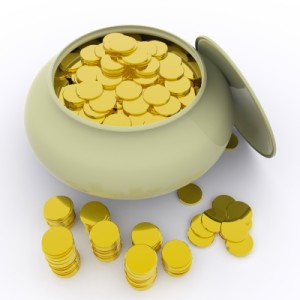I separate my retirement spending, practically — and even more importantly psychologically — into a baseline budget for basic living expenses and a discretionary fund for optional disbursements. My baseline budget covers what I have decided is the minimum lifestyle acceptable to me. The Discretionary Fund functions as a super flexible pot of money — distinct from my emergency baseline reserve — from which I can pay for goodies, fun, extras, whatever without having to worry about what that spending will do to my budget. Here is how that actually works.
The Baseline Budget
My baseline budget defines my baseline lifestyle. I have chosen to include in that baseline budget living in and up-keeping a country house (instead of a cheaper apartment), having internet access and basic drive-around gas money, eating a meat-and-vegetables diet (instead of a rice and pasta diet), drinking Chivas Regal instead of a cheaper brand, as well as a few other items that distinguish my baseline budget from the minimum budget I could probably survive on. My baseline budget raises my retirement lifestyle from minimal survival to my own personal level of baseline living comfort.
My annual baseline budget ($15,000) is what I had to have as passive income before I could stop working and retire. I had to keep working until I had crossed that passive income threshold. This is an important point, given that my key financial objective has been to retire as soon as possible in order to free up as much of my remaining life as possible. Life is a zero-sum game, after all. I — like you and everyone else — have a set and finite number of days to live. One more day working is inevitably one less day free.
I have taken one more step before turning loose my discretionary spending. Even though my entire baseline budget is covered by my Social Security “annuity” payments, I sleep better knowing that I have an emergency baseline budget reserve “just in case.” So I have one year’s baseline expenses set aside in a savings account. With that in place, I have become very comfortable with my Discretionary Fund spending.
And here is how a Discretionary Fund works for me.
My Discretionary Fund
My passive income surplus over and above that $15,000 annual (or $1250 a month) baseline budget gets moved over once a month into a separate Discretionary Fund bank account. Those discretionary monies accrue there. Whenever I want to do something optional — book a trip, buy a gadget, hire out something I could otherwise do myself — I check my Discretionary Fund balance. If I am comfortable withdrawing from that balance the cost of whatever it is I am considering doing or buying, I go ahead. And I never have to question whether “my budget” can afford the extra cost. Because that is all off budget.
And what if an unexpected unavoidable expense comes up? What if my truck dies… or the well pump goes bad… or I have to travel to see ailing family? Well, my uncommitted Discretionary Fund stands there ready to bail me out.
This way of handling my finances has had a lot of benefits for me.
Benefits of a Fund Approach To My Discretionary Spending
First and foremost, separating my wants from my baseline needs made it clear to me that I could stop working much sooner than I had thought. So this budgetary approach allowed me to retire years earlier to what I knew I would consider a comfortable baseline lifestyle (for me).
Second, keeping a Discretionary Fund — essentially an uncommitted pot of money — has given me maximum flexibility as to what I can do with that money. If, instead, I had developed a discretionary budget – with so much allotted to travel, and so much to entertainment, and so much to gifts, and so on — the result could have been becoming committed to recurring expenses just because I could afford them. Expenses such as car payments, time-share payments, club memberships, obligatory annual trips to destination X, and so on. And an expense that one becomes committed to can no longer be considered discretionary.
The flip side of this is that keeping my discretionary funds uncommitted allows me to pounce on and take advantage of unexpected opportunities for fun when they present themselves (like grabbing a super bargain of a boat on Craig’s List or taking off on a spur-of-the-moment camping trip.)
Thirdly, this financial planning method gives me a very solid psychological safety net regarding my financial future. It is a lot less worrisome to think about — and plan for — an unexpected drop in passive income when I only have to consider how to continue to cover my baseline budget. On that basis, it would be extremely unlikely that I would have to make any adjustments at all to that budget. Anything else would be, after all, just discretionary.
# # #
image courtesy of Stuart Miles at FreeDigitalPhotos.net








We do something similar – but we call them ‘allowances’. Essentially its a separate discretionary fund for each my husband and I, I also keep what I call a ‘slush fund’ as the more household related discretionary fund. It is a huge benefit to our relationship when we don’t have to justify every little purchase to one another!
Your 3-part allowance strategy sounds good, too. I should also mention that the Discretionary Fund I wrote about is “my” Fund. My wife has her own. And we also have a Home Repairs Fund.
Thanks for commenting.
So, where did you get the money for this discretionary fund? Is it ever replenished?
I have something I call a long-term fun budget category which covers thigns that are too expensive to afford from my monthly budget, which I would have to save up for, like vacations, electronics. So this is what I use when a good opportunity comes up, like a chance to take Spanish with friends instead of waiting until later and taking it by myself, or a chance to visit someone while they’re living in an exotic country. I think this is more like a discretionary budget than a fund. I also have budget lines for home and car maintenance and toward my next car because they are part of my baseline lifestyle desires. These things are all replenished bit by bit from each pension payment.
Then I also have some investments that I don’t currently need, but could help me deal with inflation later or hire people if I get too broken down to do some things myself or pay over-the-top medical expenses or do some renovations to the house. So maybe that’s like your discretionary fund except that I don’t expect to actually use it for a decade or two (except for renovations). But I am not really replenishing this fund. This is the last year I can add to my Roth IRA. After that I will add modest amounts to stock and I-bond purchases until inflation eats away at that ability. Then, growth will come only from interest, dividends and capital gains.
Your strategy sounds more to me like it consists of a set of specific-purpose funds. Nothing wrong with that, particularly if it’s working for you. But the way I think of (and use) a Discretionary Fund is as an UNASSIGNED and UNDEDICATED pool of money from which I fund fun (or big) things as they come up, in real time so to speak.
Like you say, whatever works is great!
Hi, Debbie…
My Discretionary Fund comes from the surplus money that’s left over every month after I finish paying all the regular bills. It’s not that it gets “replenished”… it just keeps growing. In my case, those Spanish lessons of yours would have been paid from my Discretionary Fund. Home improvements get funded from a Home Improvement Fund that we replenish whenever it dips below $6000; the replenishment comes out of discretionary funds. However, my car maintenance and medical expenses are included in my basic living expenses via monthly set asides.
Thanks for all the questions.
I think a separate bank account is a great idea. I do that for vacation, but not for all the other stuff. I think I could make my life easier by just combining a few of those discretionary categories and doing a transfer each month. Great stuff!
Well, it sure works for me. Try it!
Thanks, Vawt. Keeping separate accounts prevents confusion from messing things up.
I take a similar approach, although I am still in the process of funding that one year discretionary account. If the car holds up for another year I’m golden:)